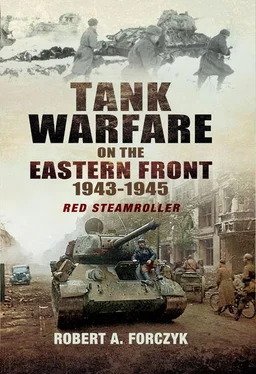At 0805 hours (local time) on 10 January 1943, Operation Koltso began with a massive 55-minute artillery barrage. Despite some cloud cover, visibility was fairly good and the Soviet artillery fire hammered the German frontline positions. In the 65th Army sector on the western side of the pocket Voronov was able to mass over 500 guns/howitzers and 450 multiple rocket launchers across a 12km-wide attack sector – the highest Soviet artillery density yet of the war. Once the artillery fire lifted, Soviet ground attack aircraft from the 16th Air Army (16 VA) strafed and bombed German positions to the rear of the HKL. Around 0900 hours, the shock groups of the 65th Army, comprised of five rifle divisions supported by the 91st Tank Brigade and six tank regiments (a total of 111 tanks) advanced against the still-smoking positions of the 44.Infanterie-Division. A squad of Soviet infantrymen was mounted on the back deck of each tank. The 65th Army had almost half of Rokossovsky’s armour, including about 60–70 KV-1S heavy tanks and 21 Churchill (Mk-IV) tanks in the 10th Guards Tank Regiment (10 GTR). The British-built Churchills were slower than the KV-1S but had slightly better armoured protection. On the flanks of the 65th Army, the 21st and 24th Armies launched smaller supporting attacks with a total of five rifle divisions and 27 tanks, intended to prevent the Germans from transferring units from these sectors to help the 44.Infanterie-Division. Clearly, the Red Army was learning how to mass combat power in a critical sector.
Although the front of the 44.Infanterie-Division was smashed in fairly quickly and four depleted infantry battalions were overrun, the remaining Sturmgeschütz and anti-tank guns inflicted a fearsome toll on the attacking Soviet armour. {9} At the tactical level, the Red Army’s coordination between tanks and infantry was still fairly primitive and a platoon of three ex-Soviet 7.62cm PaK 36 (r) anti-tank guns from Panzerjäger-Abteilung 46 was able to pick off a number of the KV-1S tanks before the unit was overrun. {10} The other Soviet supporting attacks went fairly well. In the south, the 57th Army routed the Romanian 20th Infantry Division, causing the IV Armeekorps to recoil inward, abandoning 26 of its precious PaK guns. {11} In the Marinovka salient, Hauptmann Rudolf Haen’s 1./Pz.Abt. 103 from the 3.Infanterie-Division (mot.), supported by some 8.8cm flak guns, managed to shoot up virtually all of the 21st Army’s 18 tanks. However, by the end of the second day of the offensive, the XIV Panzerkorps’ 3. and 29.Infanterie-Division (mot.) were increasingly exposed in the Marinovka salient and Haen’s Panzer-Kompanie was isolated. Overall, Hube’s corps lost 30 of its 46 tanks and 11 of 18 PaK guns in the first 48 hours of the Soviet offensive. {12} In the northwest, the 24th Army’s attack forced Strecker’s XI Armeekorps to commit the last four assault guns from Sturmgeschütz-Abteilung 177 at the Kotluban rail station. These four assault guns knocked out four Soviet tanks before two of the StuG IIIs were destroyed by direct hits and a third suffered a mobility kill when struck on its final drive. Likewise, the 6.Armee succeeded in limiting the Soviet advance by committing its remaining AFVs and PaK guns, but this only prevented a complete collapse. Due to ferocious German resistance, the Don Front suffered 26,000 casualties in the first three days of Operation Koltso and 135 out of 264 tanks were knocked out. {13} The KV-1S heavy tanks performed particularly poorly, with nearly three-quarters disabled – a very disappointing combat debut. Nevertheless, the western side of the pocket was nearly smashed in and the decimated German units from the IV and VIII Armeekorps and XIV Panzerkorps were forced to retreat toward Stalingrad. While Soviet armour losses were heavy, the Germans had also lost over 60 tanks and assault guns in the opening phase of Operation Koltso .
By 15 January, the 6.Armee had contracted into a much tighter perimeter closer to Stalingrad, but was forced to hold the outlying areas around Pitomnik and Gumrak airfields. Yet since Hube’s XIV Panzerkorps was combat ineffective after five days of fighting, Paulus no longer had the means to defend the airfields. Almost all of the German tanks and assault guns were either knocked out or immobilized by lack of fuel, although Sturmgeschütz-Abteilung 243 still had two StuG IIIs defending Pitomnik and Sturmgeschütz-Abteilung 245 had a few at Gumrak. Hauptmann Haen from Panzer-Abteilung 103 had been badly wounded in action on 13 January but he was fortunate enough to be flown out on 15 January; those panzer crewmen still on their feet were turned into infantrymen. [3]Nearly one-third of 6.Armee’s personnel had become casualties in five days of fighting, leaving fewer than 20,000 combat troops to hold the shrinking perimeter. Rokossovsky had hoped to split the German pocket into several easily-digestible sub-groups, but instead the 65th Army’s attacks from the west and the 57th Army’s attacks from south merely herded the 6.Armee in closer to Stalingrad. With only about 100 tanks still in operation, Rokossovsky used his armour in small groups to help his infantry mop up various German Stützpunkte . In some sectors, Soviet infantry was advancing with only 2–3 tanks in support, but German defensive capabilities were sharply decreased due to starvation, frostbite and limited ammunition. German Pak guns continued to destroy Soviet tanks, but now they were literally down to their last few rounds.
On 16 January, infantrymen from the 51st Army overran Pitomnik airfield. After this, the battle began to slow down as Rokossovsky shifted toward more deliberate tactics, relying upon his superior artillery to decide the issue. The Don Front’s remaining 110 tanks were reduced to a secondary role by this point and the German armour was essentially out of the battle. From 18–21 January, Rokossovsky paused his offensive in order to bring up his artillery and replenish his combat units, knowing that he could afford this luxury since Paulus could not replace any of his losses. The Luftwaffe’s aerial resupply effort was reduced to a pitiful average of 86 tons per day; German soldiers were already starving to death and the last few German tanks were now immobilized by lack of fuel. On the morning of 22 January, Rokossovsky resumed his offensive and Gumrak fell the next day, which forced the Luftwaffe to resort to parachuting in a token amount of supplies each day. After that, the Don Front slowly pummelled the 6.Armee into submission, with Paulus surrendering on 31 January. The last German troops in Stalingrad surrendered on 2 February.
Stalingrad was a debacle for the German Panzertruppe and Sturmartillerie, removing three Panzer-Divisionen and three motorized infantry divisions with a total of 12 Panzer-Abteilungen, as well as four Sturmgeschütz-Abteilungen from the Heer order of battle. Although the loss of hundreds of tanks and assault guns was serious, they could be replaced. However, the loss of more than 5,000 veteran tankers and Sturmartillerie crewmen was grievous. Some panzer crewmen, mostly wounded like Haen and Oberst Hyazinth Graf Strachwitz, had been flown out. Major Willy Langkeit, commander of the II./Panzer-Regiment 36, was one of the few able-bodied tankers flown out of the pocket and he would be instrumental in rebuilding Panzer-Regiment 36. Hitler also intervened to save a few select senior officers, such as General der Panzertruppe Hube and four infantry division commanders. However, Hitler did not order the evacuation of any of the three Panzer-Divisionen commanders; Lattman from 14.Panzer-Division and von Lenski from 24.Panzer-Division both went into Soviet captivity and later collaborated with the anti-Nazi League of German Officers (BDO). Generalleutnant Günther von Angern, commander of the 16.Panzer-Division, committed suicide on 2 February 1943.
Читать дальше








![John Stieber - Against the Odds - Survival on the Russian Front 1944-1945 [2nd Edition]](/books/405234/john-stieber-against-the-odds-survival-on-the-russian-front-1944-1945-2nd-edition-thumb.webp)



